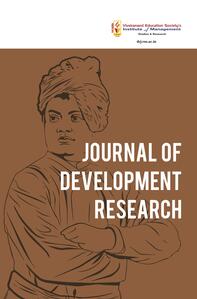
1 Department of Commerce, Assam University Diphu Campus, Diphu, Assam, India
2 Department of Commerce, Golaghat Commerce College, Golaghat, Assam, India
Creative Commons Non Commercial CC BY-NC: This article is distributed under the terms of the Creative Commons Attribution-NonCommercial 4.0 License (http://www.creativecommons.org/licenses/by-nc/4.0/) which permits non-Commercial use, reproduction and distribution of the work without further permission provided the original work is attributed.
In the modern era, overseeing employees within a company has evolved beyond traditional methods. With business expansion and technological advancements, managing employees and monitoring their performance can now be done online using human resource (HR) analytics tools. The utilisation of HR analytics leads to enhanced employee performance and improved business efficiency, including more effective recruitment, talent management, employee performance and decreased employee turnover. The assessment of different functions and the insights into employee performance provided by HR analytics are crucial for improving decision-making and giving the organisation a competitive advantage. This research seeks to investigate how HR analytics tools are used and highlight the benefits they provide to employees. Organisations can leverage existing data to address issues such as performance, employee turnover and employee attitudes using analytics tools. The motivation behind this research is the shortage of human resources in many organisations. Despite the challenges faced by human resources, the technological landscape has given rise to numerous analytical tools that are being adopted by large companies. The findings of the study underscore the pivotal role played by HR analytics in shaping office behaviour and the work environment.
HR analytics, analytics tools, employees, private bank
Introduction
Human resource (HR) analytics has made it easier to collect, analyse and measure HR data within organisations. It combines statistical methods to facilitate the collection, interpretation, measurement and prediction of data. HR analytics enlightens techniques to solving organisational problems and making correct decisions. HR analytics consequently aligns HR strategy with the overall enterprise method to obtain an aggressive benefit. HR analytics has handed through levels of measuring the sub-HR capabilities (Adeyanju, 2012). HR analytics affords diverse possibilities to the enterprise as it forecasts the body of workers necessities, permits HR to obtain corporate goals and improves organisational performance, which facilitates agencies in finding fulfilment. Despite the success, the business faces a few hugely demanding situations like records governance, talent holes amongst personnel, pinnacle control help and lots of other such challenges in enforcing and the usage of the HR analytics tool in enterprises.
Assessing the performance of employees and staff is essential in HR management to achieve organisational goals through the use of tools, techniques, practices and strategies. Any business relies on people as crucial assets, and the HR department plays a significant role in linking HR actions with business outcomes to impact organisational performance. The HR function within an organisation, like every other function, is critical, but it has historically lagged behind due to its emphasis on quantifiable metrics and data scorecards.
In recent years, the company has experienced significant growth, especially in the service sector in the 21st century (Babynina, 2021). Industries have rapidly developed new advanced practices and technologies, leading to improved company operations and efficient growth. Enterprises are striving to enhance their competitive advantages by adopting technologies and practices that support HR management, a vital function in any company. It is the one function within an organisation that plays a crucial role in its people.
Types of Human Resource Analytics
The Gartner standard describes various aspects of HR analytics as follows (Di Claudio, 2019). The description provides an overview of HR data. Historical data are analysed to interpret results, including the use of key performance indicators and dashboards for data interpretation.
Diagnose: What is the purpose of HR data? It allows for a more thorough examination of descriptive data.
Prediction: The ‘what will happen’ in HR data is described using statistical models for predicting outcomes. It provides information about future events.
Writing: Demonstrate understanding of HR data and provide evidence-based conclusions. It uses simulation and optimisation techniques.
Review of Literature
Reddy and Keerthi (2017) in a study on effective evidence-based HRM tools, highlighted the importance of prioritising human resources as the most valuable asset to a firm. They emphasised that adopting an evidence-based approach is the best way for businesses to make decisions, and HR analytics not only supports this but also motivates firms to maintain quality data to validate ROI in HR investments.
Opatha (2020) in his study discovered the importance of HR analytics in the PA system and its influence on staff motivation to enhance performance by presenting a conceptual model. HR analytics evaluated accuracy through expert data analysis tools. Along with other assumptions for managing performance among scholars, this report proposed other avenues for future research to better the discipline. In the PA system, they uncovered how HR analytics significantly impacts staff motivation and performance improvement through a conceptual model. The accuracy of HR analytics was assessed using expert data analysis tools. The report also suggested new research paths to advance the field of performance management.
Opatha’s ‘study concluded that HR analytics leverages data and statistical models to provide insights for better decision-making, empowering managers to optimise human resource management through data analysis tools and techniques’.
As stated by Anita and Sumathi (2019),
An examination into the evaluation of HR analytics on performance management in the service industry of chosen companies in Chennai delved into the influence of the performance management system on employee performance and the potential outcomes of various stages within the system. The study aimed to assess the correlation between the performance management system and employee performance, to scrutinize this correlation using the WERS 2004 dataset, and to ascertain the characteristics of the relationship in order to formulate recommendations.
As per Muhammad et al. (2021),
It was found that every organization’s management should enhance their performance management system to ensure continuity. The report recommends that management should identify and address staff concerns, supporting them as a cohesive team. Organizations are encouraged to use recognition measures to motivate staff, as employees are more driven to achieve objectives when their efforts are acknowledged and appreciated. Additionally, involving employees in goal setting and rewarding their efforts is key to driving performance.
According to Nucleus Research in 2014, for every dollar spent, analytics generates a return of $13.01.
As observed by George and Kamalanabhan (2016), ‘In a study on the acceptance of HR analytics in organizations, it is noted that the growing popularity of business analytics is evident in the global business analytics software market, which was valued at $40 million with a growth rate of 6.5%’.
The Workforce Analytics Market Analysis ‘conducted in 2018 and 2025, with a published date of June 2017 and base year for estimate 2016, valued the global workforce analytics market size at USD 430.9 million in 2015’.
Anushree Sharma’s report on People Matters stated that the global HR analytics market is expected to grow by around 12% at CAGR between 2019 and 2025, as estimated in the report ‘Outlook on the World HR Analytics Market, 2019–2025’.
Objectives
The study tries to understand HR analytics in private banks and the perceived benefits of employees.
The study focuses on how HR services are used at work.
The study aims to identify more about the potential risks and benefits of using HR analytics.
Research Methodology
Period of the study: Data was collected from the respondent from 5 November 2023 to 29 February 2024. Sample size: A sample of 250 members of the HR departments of different organisations participated in a survey to discover more regarding the benefits, challenges and impact of modernising HRM through the use of HR analytics. The responses are measured using a 5-point Likert scale, with five options provided for each instrument ranging from 1, Strongly Disagree (SD), to 5, Strongly Agree (SA). Respondents were asked to select one of the five options for each instrument. Some of the questions are open-ended.
Sampling technique: Simple random sampling is used for data collection via both questionnaires and Google Forms. The respondents are from various organisations in the Golaghat district of Assam, India. The respondents are selected from private organisations.
An investigation into HR analytics and organisational performance was created and tested via both online and offline methods. Before distribution, the survey underwent preliminary testing among HR managers and senior managers familiar with the organisation’s performance metrics to ensure its credibility. Following minor adjustments to ensure credibility, the survey was distributed to HR managers, business partners and senior management teams in 200 organisations across sectors such as accounting, legal, banking and financial services, marketing, ICT, HR and insurance (Momin & Taruna, 2015).
To evaluate the representativeness and identify differences between the valid sample and the excluded responses, a one-way analysis of variance was conducted. Furthermore, a comparative analysis of early and late responses was conducted to determine the sample’s representativeness, in accordance with previous research that has examined non-response bias by comparing demographic and contextual variables between early and late respondents (Armstrong & Overton, 1977; Guthrie et al., 2009; McCartney & Fu, 2022; Novo Melo & Machado, 2021; Wilcox et al., 1994).
Statistical tools: The data are analysed using the mean, t-test and standard deviation.
Limitation of the study: Respondents fear giving data due to privacy concerns and fear compromising their identity. Upon examination, it seems that 50 participants either left their response sheets completely blank or placed check marks in multiple options for each question. Consequently, these 50 responses were not taken into account. Time is also one of the constraints.
Analysis and Interpretation
The Importance of Human Resource Analytics in HR
HR analytics plays an important role in HR. By using analytics, HR operations can be adjusted more quickly and proven when decisions are made. HR analytics collects and evaluates historical data to provide positive and negative results to the organisation. It can easily measure the organisation’s performance against competitors. HR analytics helps in planning the business, competitive advantage, hiring employees, using data, creating insights and models for the organisation, assisting business management, data management, design model selection, etc. (Poba-Nzaou, et al., 2020; Thakre, 2020; Ulrich et al., 2010). Some of the important roles of analytics in HR are discussed below (Figure 1).
Personnel Management.
The management of personnel in a business is significantly influenced by HR analytics. Employee profiles, including knowledge, skills, experience and more, are stored using this tool. It contains data that assist HR departments in analysing resumes and other relevant information using different metrics during the hiring process. The reasons for fluctuations in the organisation’s attrition rate are evaluated by HR analytics. This includes the employee’s job interest, job engagement, years on the job and other relevant employee information.
Figure 1. Role of Human Analytics.
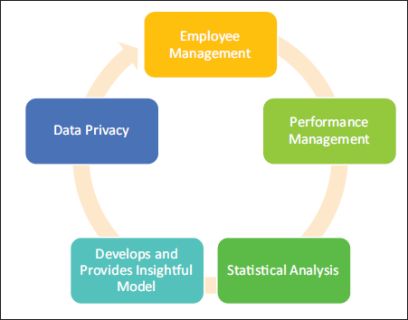
Source: https://rcm.ac.in/importance-of-hr-analytics-in-the-era-of-2020-post-covid-19.
Performance Management.
HR analytics aids in establishing a method to gauge employee performance by providing indicators of both high and low performance. Current performance and areas for improvement are provided by HR analytics. This illustrates the nature and manner of employees’ work.
Analytics.
Data collected using HR analytics is collected for the purpose of analysing the data. HR analytics helps in the integration of data and provides employees with input-output analysis, cost-effectiveness and social network analysis, which can be analysed through statistical analysis of HR analytics. This tool will also help evaluate employee satisfaction and performance. This plays an important role in the planning and implementation of the project, enabling communication and discussion. For example, HR analysis can be used to assess the risk of loss.
Create and Deliver Strategic Recommendations.
HR analytics tools use metrics to help generate data that inform organisational impact. These models are generated to offer valuable insights for recognising underperformance as well as determining the factors that impact productivity positively or negatively.
Data Privacy.
Securing data privacy is crucial for organisations to shield themselves from potential threats. HR analytics effectively handles and safeguards extensive data.
If an organisation uses HR analytics, the data cannot be controlled, and illegal use of the data is impossible.
Use of HR Analytics
The banks that were not open to the public were facing challenges in managing the growth in employee performance and retaining their staff. During that period, the industry was hiring candidates with work experience, assuming that experienced personnel would make a greater impact on the organisation. As a result, the company experienced a 10% decrease in the hiring of recent graduates. The analysis team in HR collected data from 47,000 employees in order to examine the relationship between tenure and attrition. The information uncovered that staff members recruited straight out of college had a tendency to remain with the organisation for a longer duration compared to those with greater experience. The findings also indicated that there was little difference in the contributions of fresh graduates and experienced staff to the organisation.
Upon reviewing the findings, the company introduced a new leadership development programme aimed at reducing turnover rates among recent college graduates. The company experienced a 20% rise in hiring recent graduates as a result of HR research, leading to reduced turnover and sustained employee performance (Zeidan & Itani, 2020).
Challenges Faced by HR
Human useful resource (HR) departments inside the banking enterprise face numerous challenges that are particular to the sector:
Acquiring and retaining expertise: The banking sector faces significant challenges in luring and retaining top talent. Bank employees frequently need specialised knowledge and abilities in addition to an awareness of banking laws and economics. It can be challenging to find and retain such talent, especially when competing with various businesses and financial institutions that offer alluring reimbursement plans.
Era and digital transformation: The banking sector is experiencing a virtual transformation and significant technological advancements. This presents challenging circumstances for HR departments in terms of retraining and upskilling staff to adapt to new technologies and shifting job requirements. HR must identify the skills that are essential for the future and guarantee that employees have access to sufficient education and professional development opportunities to remain employable in the digital era.
Regulatory compliance: There are a lot of requirements and compliance requirements for the banking sector. HR departments want to guarantee that staff members understand those policies, receive the necessary training and follow compliance guidelines. Maintaining a compliant lifestyle while working for an employer is crucial to avoiding fines and harm to one’s reputation.
Employee diversity and inclusion: HR departments must take on the task of promoting diversity and inclusion in the banking sector, establishing an inclusive workplace.
Change control: Whether it’s mergers and acquisitions, reorganisations, or innovations in technology, the banking sector examines frequent changes. In order to effectively manage those changes, HR departments must speak with staff members, address their concerns and provide guidance during times of transition.
Lack of sufficient IT resources: Integrating analytics into HR requires a significant amount of IT resources, which many companies, particularly smaller ones, may not possess. Additionally, setting up the necessary infrastructure could be a costly and time-consuming endeavour for these companies, leading them to avoid implementing analytics in HR processes.
Data diversity: HR utilises a range of tools for various services obtained from different providers. However, these tools often operate independently, presenting a significant challenge for organisations. To effectively leverage HR analytics, companies will need to consolidate these separate systems, which in itself is a complex task.
Concerns about privacy and compliance: For analytics to be effective, a substantial amount of data from reliable sources is required to produce desired outcomes. HR professionals need to be cautious about privacy when obtaining information about an employee or job candidate, especially from external sources. The collection of personal information about employees could lead to legal troubles for the company.
The implementation of HR analytics presents challenges such as integrating varied data sources, ensuring data precision and cultivating expertise in predictive modelling and visualisation. Resistance to change and the imperative to safeguard sensitive employee information further complicate the adoption process.
Proactive and strategic HR practices are necessary to meet these challenges.
HR departments in the banking sector seek to work closely with senior management, stay abreast of market developments and modify their approaches frequently in order to attract, develop and hold onto the best talent possible while fostering a compliance, diversity and engagement culture. Certain critical HR functions can be outsourced to payroll and HR outsourcing companies to ensure that any areas where the boom may be lagging can be improved.
Findings of the Study
Table 1 shows demographic details of the respondents in which it is found that among a total of 250 respondents, 64.1% are male and 35.9% are female.
Table 1. Demographic Details.
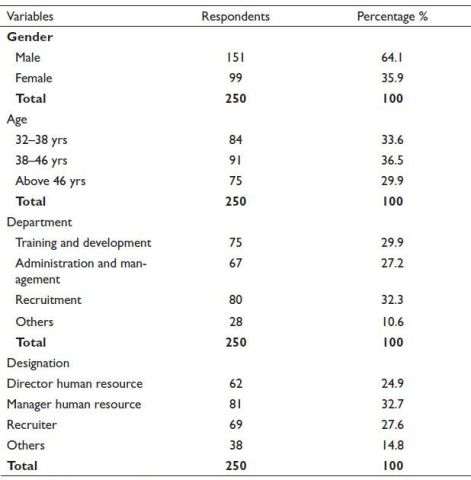
Source: Primary data collection.
Table 2. Advantages and Obstacles of Using HR Analytics to Transform Human Resource Management.
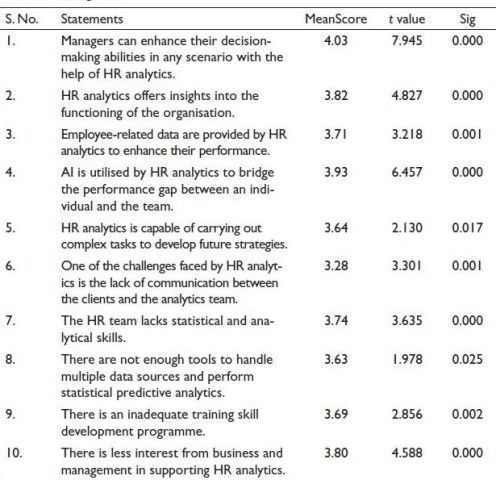
Table 2 shows the advantages and obstacles of using HR analytics to transform HR management. It is evident from the data that HR analytics significantly enhance managers’ decision-making capability in all scenarios, with an average score of 4.03, and they use AI to bridge the performance gap between individuals and teams, with an average score of 3.93. Respondents indicate that HR analytics offer valuable insights into organisational functioning, with an average score of 3.82, and note that business and management show limited interest in supporting HR analytics, with an average score of 3.80.
Table 3. Descriptive Statistics and Correlations of Study Variables.
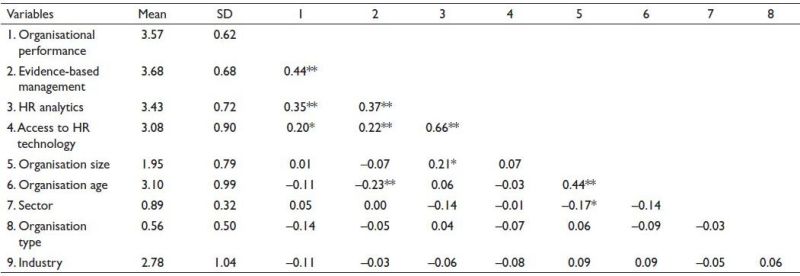
Note: N = 250 (listwise); **p < .01 *p < .05.
Table 3 shows the research variables that were analysed using Mplus 8.0 software, and the study includes descriptive statistics and correlations. A comprehensive measurement model was examined, and three primary variables (data quality, analytical capability and strategic ability to act) were loaded onto a single general factor representing HR analytics. Additionally, EBM, HR technology and organisational performance items were loaded onto their respective factors. The data exhibited a strong fit for the four-factor model (χ2/df = 236.93/143 = 1.66, p < .001; CFI = 0.95; CLI = 0.94; RMSEA = 0.07; SRMR = 0.07), with factor loadings exceeding 0.55 (p < .001).
Recommendations
Conclusion
Organisations are leveraging HR analytics to enhance their performance in response to technological and business progress. HR analytics measures concepts and methods. It provides information to the decision through statistical tools. All HR-related data are processed by HR analytics, which improves result interpretation. The analysis of this article indicates that HR professionals may not have the problem-solving skills or ability to use HR analytics tools, making it challenging to apply and use HR analytics in the workplace. Organisations may not receive senior management support as a result of these issues. Despite the difficulties, HR analytics has facilitated businesses to improve HR operations, increasing performance and achieving better results. Specific knowledge and skills can be learnt and developed in order to acquire new knowledge and skills. If an organisation meets the requirements with regulatory frameworks and best practices, information can be used and stored legally and accurately. According to this study, there are benefits and drawbacks to using and putting HR analytics into practice. However, opportunities to use HR analytics can minimise issues and promote positive organisation performance if the analysis is done in the light of the broader context. The analysis indicates that an organisation can obtain a better return on investment if it understands the purpose of using HR analytics, and the business will accept this and start dealing with this.
Declaration of Conflicting Interests
The authors declared no potential conflicts of interest with respect to the research, authorship and/or publication of this article.
Funding
The authors received no financial support for the research, authorship and/or publication of this article.
ORCID iD
Angkita Borpatra Gohain  https://orcid.org/0000-0002-9881-5958
https://orcid.org/0000-0002-9881-5958
Adeyanju, O. D. (2012). An assessment of the impact of corporate social responsibility on Nigerian society: The examples of banking and communication industries. Universal Journal of Marketing and Business Research, 1(1), 17–43.
Anita, R., & Sumathi, N. (2019). A study on the measuring the factors of HR analytics on performances management in services sector of selected companies in Chennai. JAC: A Journal of Composition Theory, 12(12).
Armstrong, J. S., & Overton, T. S. (1977). Estimating nonresponse bias in mail surveys. Journal of Marketing Research, 14(3), 396–402. https://doi.org/10.2307/3150783
Babynina, L. (2021). Transformation of approaches to human resources management in the new reality [Conference session]. Proceedings of Global Challenges and Prospects of the Modern Economic Development (GCPMED 2020), 15–16 December 2020, Samara State University of Economics, Samara, Russia.
Di Claudio, M. (2019). People analytics and the rise of HR: How data, analytics and emerging technology can transform human resources (HR) into a profit center. Strategic HR Review, 18(2), 42–46.
George, L., & Kamalanabhan, T. J. (2016). A study on the acceptance of HR analytics in organisations. International Journal of Innovative Research and Development, 5(2).
Guthrie, J. T., Coddington, C. S., & Wigfield, A. (2009). Profiles of motivation for reading among African American and Caucasian students. Journal of Literacy Research, 41, 317–353. https://doi.org/10.1080/10862960903129196
McCartney, S., & Fu, N. (2022). Bridging the gap: Why, how and when HR analytics can impact organizational performance. Management Decision, 60(13), 25–47. https://doi.org/10.1108/MD-12-2020-1581
Momin, M. W., & Taruna. (2015). HR analytics transforming human resource management. IJAR, 1(9), 688–692.
Muhammad, S., Khan, I., & Hameed, F. (2022). The impact of performance management system on employees performance. International Journal of Business and Management Sciences, 2(3), 38–47.
Novo Melo, P., & Machado, C. (2021). The role of HR analytics for digital HRM transformation [Conference session]. INTED2021 Proceedings: 15th International Technology, Education and Development Conference, 8–9 March 2021.
Opatha, H. H. D. P. J. (2020). HR analytics: A literature review and new conceptual model. International Journal of Scientific and Research Publications, 10(6).
Poba-Nzaou, P., Galani, M., & Tchibozo, A. (2020). Transforming human resources management in the age of Industry 4.0: A matter of survival for HR professionals. Strategic HR Review, 19(6), 273–278.
Reddy, R. P., & Keerthi, P. L. (2017). HR analytics’ - An effective evidence based HRM tool. International Journal of Business and Management Invention, 6(7), 23–34.
Thakre, N. (2020). Human resource (HR) analytics for organizational transformation and effectiveness. Training & Development Journal, 50(1 & 2), 47–51.
Ulrich, D., Allen, J., Brockbank, W., Younger, J., & Nyman, M. (2010). HR transformation: Building human resources from the outside in. NHRD Network Journal, 3(4), 102–102.
Yan den Heuvel, S., & Bondarouk, T. (2017). The rise (and fall?) of HR analytics. Journal of Organizational Effectiveness: People and Performance, 4(2), 157–178.
Zeidan, S., & Itani, N. (2020). HR analytics and organizational effectiveness. International Journal on Emerging Technologies, 11(2), 683–688.